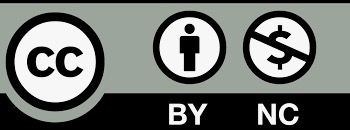Published
2016-08-06
Issue
Section
Research Articles
License
The journal adopts the Attribution-NonCommercial 4.0 International (CC BY-NC 4.0), which means that anyone can reuse and redistribute the materials for non-commercial purposes as long as you follow the license terms and the original source is properly cited.
Author(s) shall retain the copyright of their work and grant the Journal/Publisher rights for the first publication with the work concurrently licensed since 2023 Vol.8 No.2.
Under this license, author(s) will allow third parties to download, reuse, reprint, modify, distribute and/or copy the content under the condition that the authors are given credit. No permission is required from the authors or the publisher.
This broad license intends to facilitate free access, as well as the unrestricted use of original works of all types. This ensures that the published work is freely and openly available in perpetuity.
By providing open access, the following benefits are brought about:
- Higher Visibility, Availability and Citations-free and unlimited accessibility of the publication over the internet without any restrictions increases citation of the article.
- Ease of search-publications are easily searchable in search engines and indexing databases.
- Rapid Publication – accepted papers are immediately published online.
- Available for free download immediately after publication at https://esp.as-pub.com/index.php/ESP

Copyright Statement
1.The authors certify that the submitted manuscripts are original works, do not infringe the rights of others, are free from academic misconduct and confidentiality issues, and that there are no disputes over the authorship scheme of the collaborative articles. In case of infringement, academic misconduct and confidentiality issues, as well as disputes over the authorship scheme, all responsibilities will be borne by the authors.
2. The author agrees to grant the Editorial Office of Environment and Social Psychology a licence to use the reproduction right, distribution right, information network dissemination right, performance right, translation right, and compilation right of the submitted manuscript, including the work as a whole, as well as the diagrams, tables, abstracts, and any other parts that can be extracted from the work and used in accordance with the characteristics of the journal. The Editorial Board of Environment and Social Psychology has the right to use and sub-licence the above mentioned works for wide dissemination in print, electronic and online versions, and, in accordance with the characteristics of the periodical, for the period of legal protection of the property right of the copyright in the work, and for the territorial scope of the work throughout the world.
3. The authors are entitled to the copyright of their works under the relevant laws of Singapore, provided that they do not exercise their rights in a manner prejudicial to the interests of the Journal.
About Licence
Environment and Social Psychology is an open access journal and all published work is available under the Creative Commons Licence, Authors shall retain copyright of their work and grant the journal/publisher the right of first publication, and their work shall be licensed under the Attribution-NonCommercial 4.0 International (CC BY-NC 4.0).
Under this licence, the author grants permission to third parties to download, reuse, reprint, modify, distribute and/or copy the content with attribution to the author. No permission from the author or publisher is required.
This broad licence is intended to facilitate free access to and unrestricted use of original works of all kinds. This ensures that published works remain free and accessible in perpetuity. Submitted manuscripts, once accepted, are immediately available to the public and permanently accessible free of charge on the journal’s official website (https://esp.as-pub.com/index.php/ESP). Allowing users to read, download, copy, print, search for or link to the full text of the article, or use it for other legal purposes. However, the use of the work must retain the author's signature, be limited to non-commercial purposes, and not be interpretative.
Click to download <Agreement on the Licence for the Use of Copyright on Environmental and Social Psychology>.
How to Cite
Framing of climate issues and “COP21”: U.S. newspaper coverage vs Indian newspaper coverage
Masudul Karim Biswas
UBC Urban Studies Lab, University of British Columbia
Nam Young Kim
Sam Houston State University
DOI: https://doi.org/10.18063/ESP.2016.02.002
Keywords: climate change, news frames, U.S. newspapers, Indian newspapers, Paris Climate Conference, content analysis
Abstract
Using content analysis method and the theory of framing, this study compares news coverage of climate issues around the Paris Climate Conference 2015, also known as “COP21”, between U.S. and Indian newspapers. The findings, based on an analysis of 278 stories published by four leading newspapers in these countries, suggest that international politics-oriented conflict and strategy frame and environmental consequences frame dominated both U.S. and Indian newspaper coverage. Another important finding of this study is the Indian newspaper coverage, compared to the U.S. newspaper coverage, included more information on social progress and innovations toward environment-friendly initiatives.References
[1]. Babbie E, 2004, The Practice of Social Research, 10th edn. Belmont, CA: Wadsworth.
[2]. Biswas M K, 2011, Ethnic online newspapers vs. mainstream online newspapers: a comparison of the news coverage of the 2010 Health Care Reform Debate (Unpublished doctoral dissertation). Baton Rouge: Louisiana State University.
[3]. Boykoff J M and Boykoff M T, 2004, Balance as bias: global warming and the US prestige press. Global Environmental Change-Human and Policy Dimensions, vol.14(2): 125–136. http://dx.doi.org/10.1016/j.gloenvcha.2003.10.001
[4]. Das J, 2012, Environmental journalism in Bangladesh: active social agency. Journalism Studies, vol.13(2): 226–242. http://dx.doi.org/10.1080/1461670X.2011.646400
[5]. Environment and Social Psychology (2016)–Volume 1, Issue 2 151
[6]. Davenport C, Gillis J, Chan S, et al. 2015, Highlights of the Climate Change Conference 2015, The New York Times, December 12, 2015, viewed April 4, 2016, <http://www.nytimes.com/interactive/2015/12/12/world/paris-climate-change-deal-explainer.html?rref=collection%2Fnewseventcollection%2Fun-climate-change-conference&action=click&contentCollection=earth®ion=rank&module=package&version=hi-hlights&contentPlacement=1&pgtype=collection>
[7]. Dirikx A and Gelders D, 2010a, Ideologies overruled? An explorative study of the link between ideology and climate change reporting in Dutch and French newspapers. Environmental Communication, vol.4(2): 190–205. http://dx.doi.org/10.1080/17524031003760838
[8]. Dirikx A and Gelders D, 2010b, To frame is to explain: a deductive frame-analysis of Dutch and French climate change coverage during the annual UN Conferences of the Parties. Public Understanding of Science, vol.19(6): 732–742. http://dx.doi.org/10.1177/0963662509352044
[9]. Dotson D M, Jacobson S K, Kaid L L, et al. 2012, Media coverage of climate change in Chile: a content analysis of conservative and liberal newspapers. Environmental Communication, vol.6(1): 64–81. http://dx.doi.org/10.1080/17524032.2011.642078
[10]. Entman R E, 1993, Framing: toward clarification of a fractured paradigm. Journal of Communication, vol.43(4): 51–58. http://dx.doi.org/10.1111/j.1460-2466.1993.tb01304.x
[11]. Eskjær M, 2013, The regional dimension: how regional media systems condition global climate-change communication. Journal of International and Intercultural Communication, vol.6(1): 61–81. http://dx.doi.org/10.1080/17513057.2012.748933
[12]. Gitlin T, 1980, The Whole World is Watching: Mass Media in the Making and Unmaking of the New Left. Berkeley, CA: The University of California Press.
[13]. Goffman E, 1974, Frame Analysis: An Essay on the Organization of Experience. New York, NY: Harper & Row.
[14]. Hallin D C and Mancini P, 2004, Comparing Media Systems: Three Models of Media and Politics. Cambridge: Cambridge University Press.
[15]. Hallin D C and Mancini P, 2005, Comparing media systems, in J Curran and M Gurevitch (eds.), Mass Media and Society, 4th edn. London: Arnold, 215–233.
[16]. Krippendorff K, 2004, Content Analysis: An Introduction to its Methodology. Thousand Oaks, CA: Sage Publications, Inc.
[17]. Lee C C, Chan J M, Pan Z, et al. 2005, National prisms of a global media event, in J Curran and M Gurevitch (eds.), Mass Media and Society, 4th edn. London: Arnold, 320–335.
[18]. Liang X, Tsai J Y, Mattis K, et al. 2014, Exploring attribution of responsibility in a cross-national study of TV news coverage of the 2009 United Nations Climate Change Conference in Copenhagen. Journal of Broadcasting & Electronic Media, vol.58(2): 253–271.
[19]. http://dx.doi.org/10.1080/08838151.2014.906436
[20]. Nair N, 2014, Times of India vs Hindustan Times: TOI’s challenge to prove their superiority in circulation, viewed May 17, 2016, <http://www.india.com/stream/times-of-india-vs-hindustan-times-tois-challenge-to-prove-their-superiority-in-circulation-149078>
[21]. Nisbet M, 2009, Communicating climate change: why frames matter for public engagement. Environment, vol.51(2): 12–23. http://dx.doi.org/10.3200/ENVT.51.2.12-23
[22]. Reis R, 1999, Environmental news coverage of the Earth Summit by Brazilian newspapers. Science Communication, vol.21(2): 137–155. http://dx.doi.org/10.1177/1075547099021002003
[23]. Riffe D and Hrach T, 2009, Study explores audience's views on environmental news. Newspaper Research Journal, vol.30(3): 8–25.
[24]. Riffe D, Lacy S, and Fico F, 2005, Analyzing Media Messages: Using Quantitative Content Analysis in Research, 2nd edn. New York, NY: Routledge.
[25]. Rutledge P, 2000, What is Media Psychology? And Why You Should Care. Newport Beach, CA: Media Psychology Research Center.
[26]. Scheufele D A, 1999, Framing as a theory of media effects. Journal of Communication, vol.49(1): 103–122. http://dx.doi.org/10.1111/j.1460-2466.1999.tb02784.x
[27]. Schreiner W and Bosman J, 2012, Coverage cop-out: global media analysis points to a lack of climate change coverage. Ecquid Novi: African Journalism Studies, vol.33(1): 66–71. http://dx.doi.org/10.1080/02560054.2011.636830
[28]. Ten Eyck T A and Williment M, 2003, The national media and things genetic: coverage in The New York Times (1971–2001) and TheWashington Post (1977–2001) [Electronic Version]. Science Communication, 25(2): 129 – 152.
[29]. United Nations, n.d., Why is the conference called COP21?, viewed April 2, 2016, <http://www.un.org/sustainabledevelopment/cop21/>
[30]. United Nations Framework Convention on Climate Change, 2015, Adoption of the Paris Agreement, viewed April 4, 2016, <https://www.documentcloud.org/documents/2646274-Updated-l09r01.html>
[31]. UN Climate Change Conference Paris 2015, n.d., viewed April 5, 2016, <http://www.cop21.gouv.fr/en>
[32]. Walsh B, 2015, Obama takes the lead on climate change but needs the world to follow. Time, August 17, 7–9.
[33]. Weaver D, 1997, Framing should not supplant agenda-setting. Communication Theory & Methodology Concepts, vol.27(2): 3.
[34]. Zamith R, Pinto J, and Villar M, 2012, Constructing climate change in the Americas: an analysis of news coverage in U.S. and South American newspapers. Science Communication, vol.35(3): 334–357. http://dx.doi.org/10.1177/1075547012457470
[35]. Zhao X, Leiserowitz A A, Maibach E W, et al. 2011, Attention to science/environment news positively predicts and attention to political news negatively predicts global warming risk perceptions and policy support. Journal of Communication, vol.61: 713–731. http://dx.doi.org/10.1111/j.1460-2466.2011.01563.x







